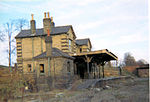Saffron Walden Grammar School
1940 disestablishments in EnglandDefunct schools in EssexEducational institutions disestablished in 1940Educational institutions established in the 1500sUse British English from September 2012
Saffron Walden Free Grammar School (or Saffron Walden Grammar School) was a school in the Essex town of Saffron Walden, which for over four hundred years educated the boys of the town and surrounding villages in a manner designed to be after the model of Eton College and Winchester. It was notable for its longevity and for some of its illustrious alumni.
Excerpt from the Wikipedia article Saffron Walden Grammar School (License: CC BY-SA 3.0, Authors).Saffron Walden Grammar School
Ashdon Road, Uttlesford Saffron Walden
Geographical coordinates (GPS) Address Phone number Website Nearby Places Show on map
Geographical coordinates (GPS)
| Latitude | Longitude |
|---|---|
| N 52.0258 ° | E 0.2524 ° |
Address
Dame Bradbury's School
Ashdon Road
CB10 2AL Uttlesford, Saffron Walden
England, United Kingdom
Open on Google Maps








